|
|
Post by flateric on Feb 17, 2009 16:34:00 GMT -5
Having fitted some new pots to my P-bass i find there is a huge amount of treble loss when I turn down the volume. Keeping tone full up anything under 2/3 vol goes muddy as a very muddy place. I know the treble bleed cap in parallel to resistor thing across the vol's in and out terminals for guitars (stay with me if I get too technical guys, heh) but never heard of it being fitted or needed for a bass.
The common values I have for a guitar treble bleed are 100k resistor in parallel with a 0.1nF cap (or is it 0.01uF?)
Am I likely to need different values for it to be effective for a bass?
|
|
|
|
Post by cynical1 on Feb 17, 2009 17:00:04 GMT -5
We had this discussion once before. I was asking pretty much the same thing. It started out as a question about Why No 3 Vol Pots...worked it's way around to solving world peace...then got onto treble bleed caps for a bass. I linked to the 3rd page, as it meanders quite a bit. I haven't built this mod as of yet, but there are some graphs that details what I found out on frequency and cap\resistor values, and some extrapolations on what it means from ChrisK and Ash. Hope it helps Happy Trails Cynical One |
|
|
|
Post by flateric on Feb 17, 2009 17:27:45 GMT -5
Thanks once more for your guidance oh cynical one. +1 for your help. I think maybe a cap and a resistor in parallel would have trouble solving world peace, but if you had an inductor, then its a different story. I'm off to inwardly digest.
|
|
|
|
Post by cynical1 on Feb 17, 2009 19:26:43 GMT -5
Well, thank you. Considering I haven't built this yet...and have no idea if it'll work...I hope it leads you in the right direction. I'm probably going to play with the following combinations: 220 K resistor and 2200 nF capacitor 270 K resistor and 2200 nF capacitor 390 K resistor and 1800 nF capacitor All three of these get you close to the curve on the guitar version of 220K\1000 pF. If you're doing a 5 string it may require more tweaking. The Java High Pass Filter app I used is a good tool to get you in the ballpark...or pitch, as the case may be... My only concern with this is how the combinations will effect the taper and function of the pot. Let me know what you find out of you finish this mod first. Happy Trails Cynical One |
|
|
|
Post by ashcatlt on Feb 18, 2009 0:25:19 GMT -5
cynical1, wasn't your thing about a bass cut control? That's a little bit different thing from the treble bleed mod. In this case, the capacitor value shouldn't have anything to do with the tuning of the instrument. I'm not so sure how much it does in the case of the bass cut, either. It is mostly dependent on the characteristics (L,C, and R) of the pickup.
I agree, though, that caps are cheap, and the easiest way to figure it out is likely just to try it.
|
|
|
|
Post by cynical1 on Feb 18, 2009 0:38:17 GMT -5
No, it was supposed to be a treble bleed. I had it drawn with the 220K resistor and 1000 pF capacitor, identical to the guitar spec. ChrisK made mention of having to modify the values for the lower octave. That's how it all got started.
I'll trial and error it and see what happens. The bass is job #3, so it'll be a while. Jobs #1 & #2 are awaiting warmer weather to finish.
Right now the bass is the only functional instrument...so I can't take that one apart just yet.
Happy Trails
Cynical One
|
|
|
|
Post by JohnH on Feb 18, 2009 1:59:21 GMT -5
Just a hopefully helpful plug: This spreadsheet was made mainly for testing things like treble bleed mods on guitar circuits. If you can find a suitable inductance and resistance value for a bass pickup, I think it would work fine for a bass circuit. guitarnuts2.proboards45.com/index.cgi?board=reference&action=display&thread=3627My expectation would be that the same values used on a guitar would also be best on a bass, since it is mostly about the cable capacitance, and we use that same cable types for both axes. John |
|
|
|
Post by cynical1 on Feb 18, 2009 3:22:47 GMT -5
Thanks John.
I don't completely understand this new toy yet...but I love interactive pictures... I'll need a good night's sleep before I play with this.
Again, you're the man...
Hey, by the way, how are you holding up to all the brush fires down there?
Happy Trails
Cynical One
|
|
|
|
Post by JohnH on Feb 18, 2009 5:07:29 GMT -5
Thanks Cyn - thanks for the thought. Where I live in New South Wales, we have not been affected by the recent fires. In fact it has been very wet. But south, in Victoria, it has been tragic, the worst fires ever.
cheers
John
|
|
|
|
Post by flateric on Feb 18, 2009 9:24:08 GMT -5
thx for the link to that modelling spreadsheet, its tremendous stuff! I've designed a mid boost circuit using a 47nf cap in a parallel treble bleed config. Any idea where I could get L,C,R infor for a P-bass pickup and a Jazz bass pair of single coils? (I can figure out the R bit.....) [edit] buildyourguitar.com/resources/lemme/table.htmthanks! |
|
|
|
Post by ashcatlt on Feb 18, 2009 13:09:20 GMT -5
Clipped from a quick google search:
"Fender Custom Shop 60's Jazz Bass® Pickups
Bridge Pickup: DC Resistance: 7.4K Bridge Pickup: Inductance: 3.25Henries Neck Pickup: DC Resistance: 7.1K Neck Pickup: Inductance: 3.18Henries..."
"Original Precision Bass DC Resistance 10.5K Inductance 6.4Henries..."
This doesn't give precise values for what you've got, but does give a ballpark and indicates that bass pickups sit right around where we might expect to see guitar pickups. No capacitance is stated. I think, though, that it's safe to assume this would be reasonably close to guitarish values as well.
|
|
|
|
Post by flateric on Feb 18, 2009 13:20:47 GMT -5
Thanks Ash, thats useful to plug into the spreadsheet. I'll use the cap values from the lemme table.
|
|
|
|
Post by ChrisK on Feb 18, 2009 17:20:26 GMT -5
I'd initially go with guitar values as well for the capacitance. One critical component is the input impedance of the amp. Some are 1 M Ohm, some are 200K Ohm, and other's are something in between. It makes a difference. I sort of "suspect" that larger values for the treble bleed cap may be necessary due to the halved frequencies. The "loudness" curve is. After all, we put tweeters on bass amps, but rarely on guitar amps. And seriously guys, find one of these from an old tube based AM radio. The three sections in parallel give a 100 to 1,400 pF tunable cap. Or, build a cap substitution box.  |
|
|
|
Post by cynical1 on Feb 18, 2009 17:31:23 GMT -5
This is definitely a project for after the taxes are done.
From preliminary toying with JohnH's spreadsheet, it doesn't seem like it'd make much difference what combination you used on a bass, as most of the bass fundamental frequencies are far below where the treble bleed seems to perform best. You might see more advantage on a 5 or 6 string bass, or improved harmonics with the volume rolled off...
I'm curious what flateric comes back with.
Happy Trails
Cynical One
|
|
|
|
Post by flateric on Feb 18, 2009 18:39:26 GMT -5
yeah - big tunable cap would be so cool. Not sure where it could be mounted though.
I had a think about the bass freqs after looking at the range of Hz on your earlier post from low E to high G on 24th fret.
But keeping the sparkle there is a lot more than the high G thing - if you put your ear up to the tweeter on my 15" bass cab, its all the harmonics and stuff way up above the high G that give the top end, and that get lost when the volume is rolled off, so I'm not so concerned about keeping it flat between 42Hz and 390Hz, it has to go right up to 3000 or 4000 to stop the tome going all muffled.
|
|
|
|
Post by newey on Feb 18, 2009 19:03:41 GMT -5
Flat-
ChrisK is talking about using this as a test rig, external to the guitar (errr...bass), so that you can see what cap value works best before installing. A higher-tech version of a cap-substitution box.
|
|
|
|
Post by ChrisK on Feb 18, 2009 21:12:33 GMT -5
Since we are discussing a treble bleed cap, it would go in place of the treble bleed cap (internal). A couple of solder-tacked-on wires to the external variable cap would do the trick. You're on your own figuring out just exactly WHAT capacitance it is that you set it to. ;D ;D I use an LCR meter. That might be why I suggested a cap substitution box.  |
|
|
|
Post by ashcatlt on Feb 18, 2009 22:51:59 GMT -5
Most of what you're hearing getting rolled off as you drop the volume control is high frequency non-harmonic information. That is, it's noise and has very little to do with what note is being played.
Some small amount might be extremely high order harmonics, but for the most part the composition of the strings and the playing technique have more to do with that band than the note itself.
|
|
|
|
Post by flateric on Feb 19, 2009 14:32:48 GMT -5
OK its wired into my P-bass. I fitted a mini DPDT switch [on-on-on] and 2 caps to the end pair of lugs. It sounds good - the trebles are preserved down to low volumes but to be honest the shift in tonal response with the different value bleed caps is quite subtle - maybe a little redistribution of the mid frequencies is heard, if anything.
Here's the spec:
250k vol + tone pots with a 0.047uF cap on the tone pot.
treble bleed: 220k resistor in parallel with choice of 560pF cap, 2.2nF cap or both together.
What is really different is the tone shaping of the tone pot. Not the normal drop off of tone but again a shifting of the mids, quite noticable and pleasing. The top end sparkle drops off a bit, but it seems to reshape the mid range more.
I've not tried it thru the main gig amp at proper volume yet, but will give it a test run tomorrow at the band practice.
|
|
|
|
Post by flateric on Feb 19, 2009 18:32:40 GMT -5
Here's the circuit:  Here's the bass with the toggle switch:  |
|